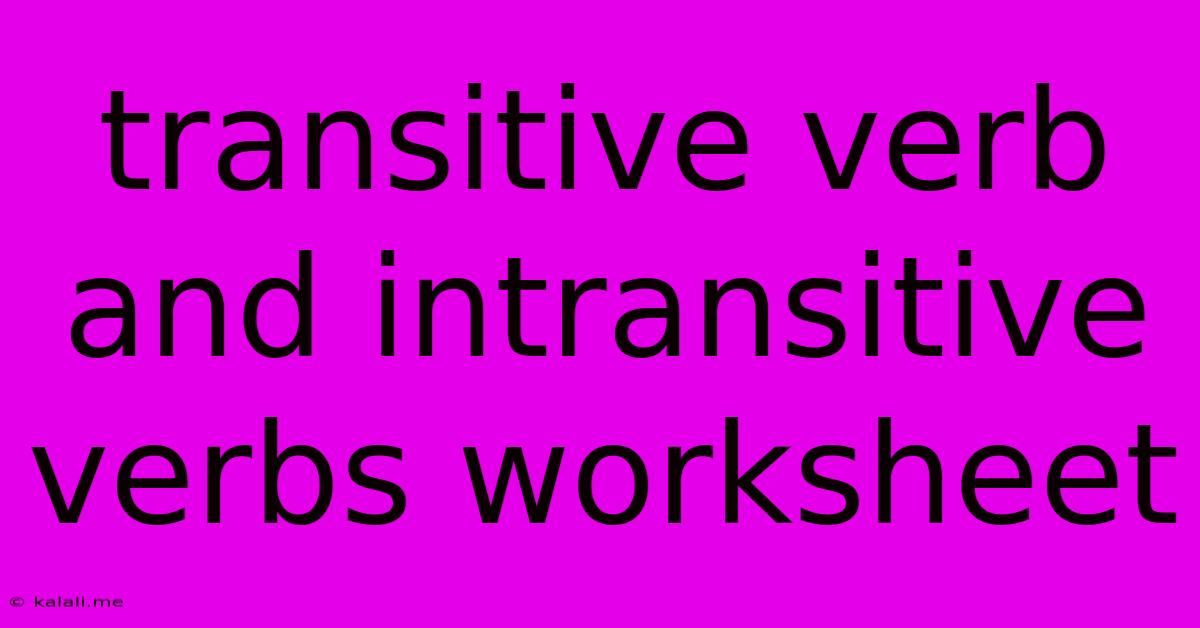Transitive Verb And Intransitive Verbs Worksheet
Kalali
Jun 13, 2025 · 2 min read

Table of Contents
Transitive and Intransitive Verbs Worksheet: A Comprehensive Guide
This article provides a comprehensive guide to transitive and intransitive verbs, including a sample worksheet to test your understanding. Understanding the difference between these verb types is crucial for mastering grammar and improving your writing skills. This worksheet will help you confidently identify and use transitive and intransitive verbs in your sentences.
What are Transitive Verbs?
Transitive verbs are action verbs that require a direct object. The direct object receives the action of the verb. Think of it as the verb "acting upon" something. To identify a transitive verb, ask yourself "What?" or "Whom?" after the verb. If you can answer the question, you've found a direct object, and the verb is transitive.
Examples of Transitive Verbs:
- She wrote a letter. (What did she write? A letter.)
- The dog chased the ball. (What did the dog chase? The ball.)
- He painted the house. (What did he paint? The house.)
- They read the book. (What did they read? The book.)
What are Intransitive Verbs?
Intransitive verbs are action verbs that do not require a direct object. They express an action or state of being without acting upon something else. You can't answer "What?" or "Whom?" after an intransitive verb.
Examples of Intransitive Verbs:
- The bird sang. (Sang what? Nothing.)
- He sleeps. (Sleeps what? Nothing.)
- The sun shines. (Shines what? Nothing.)
- The leaves fell. (Fell what? Nothing.)
Identifying Transitive and Intransitive Verbs: A Worksheet
This worksheet will help you practice identifying transitive and intransitive verbs. For each sentence, identify the verb and state whether it is transitive (T) or intransitive (I). If it's transitive, identify the direct object.
Worksheet:
- The cat sat on the mat.
- She baked a delicious cake.
- The wind howled.
- They built a magnificent castle.
- The flowers bloomed.
- He played the piano.
- The river flows.
- She ate a huge sandwich.
- The children laughed.
- He drove his car to work.
Answer Key:
(Note: This answer key is provided for self-checking purposes after completing the worksheet independently.)
- I (sat)
- T (baked a cake)
- I (howled)
- T (built a castle)
- I (bloomed)
- T (played the piano)
- I (flows)
- T (ate a sandwich)
- I (laughed)
- T (drove his car)
Further Practice and Advanced Concepts:
This worksheet provides a basic introduction. For further practice, try creating your own sentences using transitive and intransitive verbs. You can also explore more complex grammatical concepts, such as verbs that can be both transitive and intransitive depending on the context (e.g., "run"). Mastering these concepts enhances your grammatical understanding and strengthens your writing abilities. Remember to focus on understanding the core difference between a verb acting upon an object (transitive) and a verb that doesn't (intransitive). This understanding will significantly improve your sentence construction.
Latest Posts
Latest Posts
-
Which Of The Following Statements About Interjections Is False
Jun 14, 2025
-
What Is The Lcm Of 2 And 11
Jun 14, 2025
-
How Are Protists And Bacteria Different
Jun 14, 2025
-
The General Formula For The Alkane Series Is
Jun 14, 2025
-
A Fishbone Chart Is Also Known As A
Jun 14, 2025
Related Post
Thank you for visiting our website which covers about Transitive Verb And Intransitive Verbs Worksheet . We hope the information provided has been useful to you. Feel free to contact us if you have any questions or need further assistance. See you next time and don't miss to bookmark.